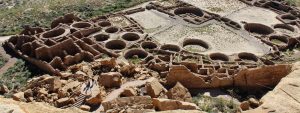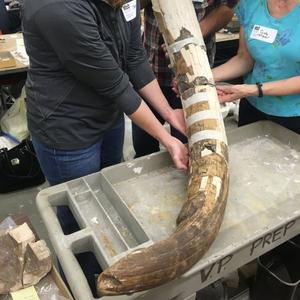Chaco Canyon, located in Northwestern New Mexico, was occupied by the ancestral Pueblo people between 830 and 1250 CE, reaching its peak between 1020 and 1110 CE (UNESCO). The canyon was a major center for political and cultural activity in the Four Corners of the American Southwest. The architecture (Figure 1) demonstrated the capability of the society’s leaders to plan and execute massive construction efforts, something that was only possible because of the immense power and influence that the leaders of the ancestral Pueblos held over the larger population.
Figure 1. The remnants of downtown Chaco Canyon feature the intricate architecture of pit houses and kivas that existed in the ancestral Pueblo’s Chaco Canyon.
Despite the evidence of a powerful political system that executed control over the area, Chaco Canyon, like other ancient civilizations, eventually fell. The lack of written records leftover makes it harder to determine the reason for Chaco Canyon’s downfall, but there are several theories as to why it occurred.
The primary reason that Chaco Canyon collapsed, according to anthropologist Steve Lekson, was a difference in spiritual beliefs between the elite of Chaco Canyon and a new group of people that moved south to the area around Chaco Canyon (CU Boulder). Additionally, the arid weather was conducive to a drought that occurred around the time of Chaco Canyon’s collapse, causing the elite to move north while another group, the Aztec Pueblo, moved south. This came together to cause conflict that politicians couldn’t control (CU Boulder).
However, another theory states that deforestation around the area in the Bonito Phase (860-1140 CE) for construction and fuel caused erosion that destroyed the agricultural fields, creating a food shortage that forced people to move away in order to survive. However, it is unclear exactly where the wood used to help construct the great houses originated from, so there is no concrete evidence to prove that deforestation incited the downfall of Chaco Canyon (Wills et. al. 2014).
Another theory describes how a drought caused the downfall of Chaco Canyon. Tree ring analysis indicated a 50-year drought that occurred in the area as the Bonito Phase was ending. (Oswald 2018). This drought would have caused resources to be scarce, beginning the decline of the civilization as people moved out of the area to ensure their survival.
There is evidence of great kivas (Figure 2) being burned and great house doors being sealed shut, indicating the possibility of spiritual acceptance and subsequent ritual burning to accept the change in conditions. (Oswald 2018). The Pueblo people’s origin stories are heavily reliant on migration, which makes sense when accounting for the likely migration of ancestral Pueblo peoples that occurred after the collapse of Chaco Canyon.
Figure 2. The remains of a great kiva in Chaco Canyon. Political gatherings and religious rituals typically occurred in these subterranean buildings.
Today, the specific reason for the downfall of Chaco Canyon is unknown. It is likely that all of the aforementioned theories come together to cause Chaco Canyon to no longer be a place of great wealth and leadership, but an environmentally and socially hostile place to be. This caused the ancestral Pueblos to migrate out of the area into areas with more stable environments.
Reference list:
“Ancient Chaco Canyon population likely relied on imported food.” University of Colorado Boulder: CU Boulder Today. Last modified December 29, 2016. Accessed November 12, 2022. https://www.colorado.edu/today/2016/12/29/ancient-chaco-canyon-population-likely-relied-imported-food.
“Chaco Culture.” UNESCO: World Heritage Convention. Accessed November 12, 2022. https://whc.unesco.org/en/list/353/#:~:text=The%20Chacoan%20society%20reached%20its%20height%20between%20about%201020%20and%201110.
“Misunderstanding The Prehistoric Southwest: What Happened At Chaco?” University of Colorado Boulder: CU Boulder Today. Last modified February 16, 2003. Accessed November 12, 2022. https://www.colorado.edu/today/2003/02/16/misunderstanding-prehistoric-southwest-what-happened-chaco.
Oswald, Benjamin. “Chaco Canyon.” World History Encyclopedia. Last modified June 29, 2018. Accessed November 12, 2022. https://www.worldhistory.org/Chaco_Canyon/.
Wills, W. H., Brandon L. Drake, and Wetherbee B. Dorshow. “Prehistoric Deforestation at Chaco Canyon?” National Library for Biotechnology Information: National Library of Medicine. Last modified August 12, 2014. Accessed November 12, 2022. https://www.ncbi.nlm.nih.gov/pmc/articles/PMC4136604/.
Additional Content:
https://www.youtube.com/watch?v=o6i4NXN8ago&ab_channel=Megaprojects




